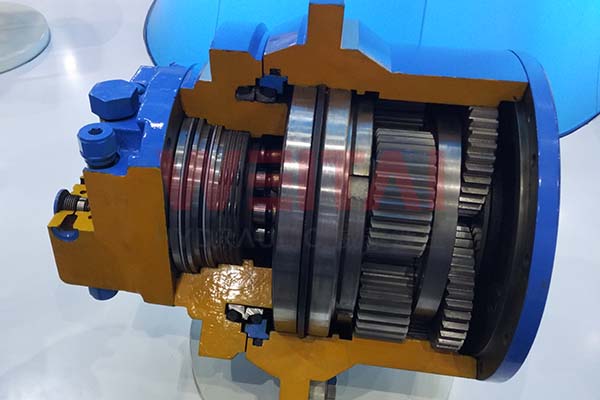Understanding the technical breakdown of the hydraulic wheel motor gives us insights into how this important component makes so many machines function, from industrial equipment to specialized vehicles.

Technical Breakdowns of Hydraulic Wheel Motor
The hydraulic wheel motor is a remarkable engineering component that plays a crucial role in various machinery.
At its core, the hydraulic wheel motor operates on the principle of fluid power. Hydraulic fluid, which is pressurized, is the lifeblood of this system. The pump forces the fluid through a series of channels and into the motor.
Inside the motor, there are components like pistons. These pistons are actuated by the incoming pressurized fluid. As the fluid enters the piston chambers, it exerts force on the pistons, causing them to move. This linear motion of the pistons is then converted into rotational motion. The pistons are connected to a shaft, and as they move, they turn the shaft.
Valves within the hydraulic wheel motor are also essential. They control the flow of the hydraulic fluid. For example, inlet valves allow the fluid to enter the motor at the right time and in the correct amount. Outlet valves, on the other hand, manage the fluid as it exits after doing its work. These valves are carefully calibrated to ensure smooth operation and to maintain the correct pressure levels.
The seals in a hydraulic wheel motor are vital for preventing leaks. They keep the hydraulic fluid where it needs to be and prevent contaminants from entering the system. Without proper seals, the motor would lose efficiency and could potentially fail.
The housing of the hydraulic wheel motor is designed to protect the internal components and also to dissipate heat. As the motor operates, there is friction and energy conversion, which generates heat. The housing helps to transfer this heat away from the critical parts, ensuring the longevity of the motor.
In different applications, the design of the hydraulic wheel motor may vary. In heavy-duty construction vehicles, the motors need to be robust and capable of handling high torque and power. In contrast, for some smaller machinery, the focus might be on efficiency and compactness.
Maintenance and Troubleshooting of Hydraulic Wheel Motor
A well-maintained hydraulic wheel motor is crucial for the smooth operation of machinery and vehicles. Here’s what you need to know about keeping these motors in top shape and how to address common issues.
Regular Maintenance Practices
Fluid Checks and Changes
Hydraulic fluid is the lifeblood of the wheel motor. Regularly checking the fluid level is essential. Low fluid levels can cause overheating, increased wear on components, and ultimately, motor failure. Use the appropriate dipstick to measure the fluid level and ensure it is within the recommended range. Additionally, the fluid quality should be monitored. Over time, the fluid can become contaminated with dirt, water, or metal shavings. Contaminated fluid can damage seals, valves, and other internal parts. Follow the manufacturer’s guidelines for fluid change intervals. This typically ranges from every few months to a year or more, depending on usage.
Seal and Gasket Inspections
Seals and gaskets play a vital role in preventing leaks. Inspect them regularly for signs of wear or damage. Look for cracks, swelling, or hardening. If a seal is damaged, it can lead to fluid leakage, which not only reduces the efficiency of the motor but can also cause safety hazards. Replace any damaged seals promptly using high-quality replacement parts that are compatible with the hydraulic system.
Filter Maintenance
Filters in the hydraulic system trap contaminants and keep the fluid clean. Clean or replace the filters as recommended. A clogged filter can restrict the flow of fluid, leading to reduced motor performance and potential overheating. Some filters are reusable and can be cleaned with a suitable solvent, while others need to be replaced regularly.
Troubleshooting Common Problems
Leakage Issues
If you notice hydraulic fluid leaking around the motor, first identify the source. It could be a damaged seal, a loose fitting, or a cracked hose. Tighten any loose fittings and replace damaged hoses or seals. Check the connection points for signs of corrosion or damage. If the leak persists, it may be necessary to disassemble the motor and conduct a more detailed inspection.
Overheating
Overheating can be caused by a variety of factors, including low fluid levels, clogged filters, or a malfunctioning cooling system. If the motor is overheating, stop the machinery immediately to prevent further damage. Check the fluid level and quality, clean or replace the filters, and ensure the cooling system is functioning properly. Fans, radiators, or cooling fins may need to be cleaned or repaired.
Reduced Performance
If the hydraulic wheel motor is not providing the expected power or speed, there could be several reasons. Check the pressure settings to ensure they are correct. Low pressure can result in reduced performance. Inspect the pump for signs of wear or damage. A worn pump may not be able to provide the necessary pressure. Also, look for any blockages in the hydraulic lines that could restrict the flow of fluid.
Unusual Noises
Strange noises coming from the motor can indicate a problem. It could be due to worn bearings, damaged gears, or air in the hydraulic system. If air is present, bleed the system according to the manufacturer’s instructions. For mechanical issues like worn bearings or gears, the motor may need to be disassembled and the damaged parts replaced.
Conclusion
By following a regular maintenance schedule and being able to quickly diagnose and fix common problems, you can extend the life of your hydraulic wheel motor and ensure the reliable operation of your equipment.
Post time: Oct-12-2024
